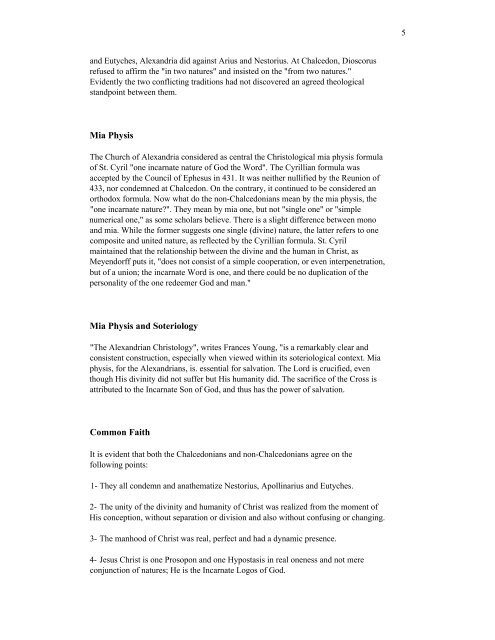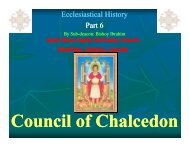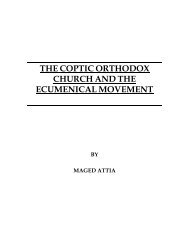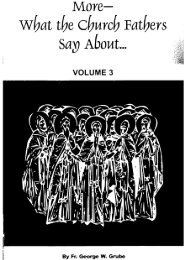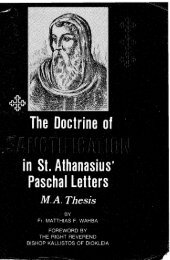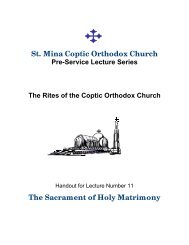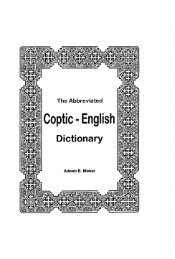Coptic interpretations of the Fourth Ecumenical Council - Saint Mina ...
Coptic interpretations of the Fourth Ecumenical Council - Saint Mina ...
Coptic interpretations of the Fourth Ecumenical Council - Saint Mina ...
Create successful ePaper yourself
Turn your PDF publications into a flip-book with our unique Google optimized e-Paper software.
and Eutyches, Alexandria did against Arius and Nestorius. At Chalcedon, Dioscorus<br />
refused to affirm <strong>the</strong> "in two natures" and insisted on <strong>the</strong> "from two natures."<br />
Evidently <strong>the</strong> two conflicting traditions had not discovered an agreed <strong>the</strong>ological<br />
standpoint between <strong>the</strong>m.<br />
Mia Physis<br />
The Church <strong>of</strong> Alexandria considered as central <strong>the</strong> Christological mia physis formula<br />
<strong>of</strong> St. Cyril "one incarnate nature <strong>of</strong> God <strong>the</strong> Word". The Cyrillian formula was<br />
accepted by <strong>the</strong> <strong>Council</strong> <strong>of</strong> Ephesus in 431. It was nei<strong>the</strong>r nullified by <strong>the</strong> Reunion <strong>of</strong><br />
433, nor condemned at Chalcedon. On <strong>the</strong> contrary, it continued to be considered an<br />
orthodox formula. Now what do <strong>the</strong> non-Chalcedonians mean by <strong>the</strong> mia physis, <strong>the</strong><br />
"one incarnate nature?". They mean by mia one, but not "single one" or "simple<br />
numerical one," as some scholars believe. There is a slight difference between mono<br />
and mia. While <strong>the</strong> former suggests one single (divine) nature, <strong>the</strong> latter refers to one<br />
composite and united nature, as reflected by <strong>the</strong> Cyrillian formula. St. Cyril<br />
maintained that <strong>the</strong> relationship between <strong>the</strong> divine and <strong>the</strong> human in Christ, as<br />
Meyendorff puts it, "does not consist <strong>of</strong> a simple cooperation, or even interpenetration,<br />
but <strong>of</strong> a union; <strong>the</strong> incarnate Word is one, and <strong>the</strong>re could be no duplication <strong>of</strong> <strong>the</strong><br />
personality <strong>of</strong> <strong>the</strong> one redeemer God and man."<br />
Mia Physis and Soteriology<br />
"The Alexandrian Christology", writes Frances Young, "is a remarkably clear and<br />
consistent construction, especially when viewed within its soteriological context. Mia<br />
physis, for <strong>the</strong> Alexandrians, is. essential for salvation. The Lord is crucified, even<br />
though His divinity did not suffer but His humanity did. The sacrifice <strong>of</strong> <strong>the</strong> Cross is<br />
attributed to <strong>the</strong> Incarnate Son <strong>of</strong> God, and thus has <strong>the</strong> power <strong>of</strong> salvation.<br />
Common Faith<br />
It is evident that both <strong>the</strong> Chalcedonians and non-Chalcedonians agree on <strong>the</strong><br />
following points:<br />
1- They all condemn and ana<strong>the</strong>matize Nestorius, Apollinarius and Eutyches.<br />
2- The unity <strong>of</strong> <strong>the</strong> divinity and humanity <strong>of</strong> Christ was realized from <strong>the</strong> moment <strong>of</strong><br />
His conception, without separation or division and also without confusing or changing.<br />
3- The manhood <strong>of</strong> Christ was real, perfect and had a dynamic presence.<br />
4- Jesus Christ is one Prosopon and one Hypostasis in real oneness and not mere<br />
conjunction <strong>of</strong> natures; He is <strong>the</strong> Incarnate Logos <strong>of</strong> God.<br />
5


